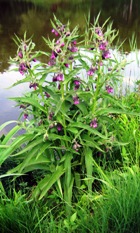
Plant Part: Leaves
Extraction: Infused in Vegetable Oil
Growing Practice: Ethical
Country of Origin: USA
BioChemicals: Allantoin (up to 4.7%)
Mucilage (29%)
Triterpenoids
Phonolic acids (rosmarinic acid)
Pyrrolizidine alkaloids (0.02% - 0.07%) (should not be taken internally]
Tannins
Plant Information for Comfrey (Symphytum officinale)
Comfrey (Symphytum officinale) of Family Boraginaceae is a perennial herb with a black, turnip-like root and large, hairy broad leaves and small bell-shaped flowers. Native to Europe, it has been used as an organic fertilizer because of its ability to mine nutrients from the soil that can be used to fertilize other plants.
The roots and the leaves are useful medicinally; however it should not be taken internally (see Safety section).
The infused oil can be used on arthritic joints, sprains, bruises, and other trumatic injuries and for inflamed bunions.![]()
At the end of the nineteenth century there was progress in studying the reasons why comfrey works, but about the same time that allantoin was discovered its use was reduced because of changes in medical theory.![]()
Herbs2000 and other sites discuss research that shows that has isolated substances pyrrolizidine alkaloids (found mostly in the roots) are highly toxic to the liver. This issue seems to be in need of more research. One source suggests that the common comfrey is safer than some other species. Because of this uncertainty, Comfrey should probably not be used internally.
The information provided on these pages is not a substitute for necessary medical care, nor intended as medical advice. Always keep carriers and bases tightly closed and in a cool, dark place, out of reach of children. If redness or irritation occurs when applied to the skin, stop using immediately and contact your health provider if necessary.![]()
all images and content copyright ©2000—2020 by suzumebachi design and samara botane





